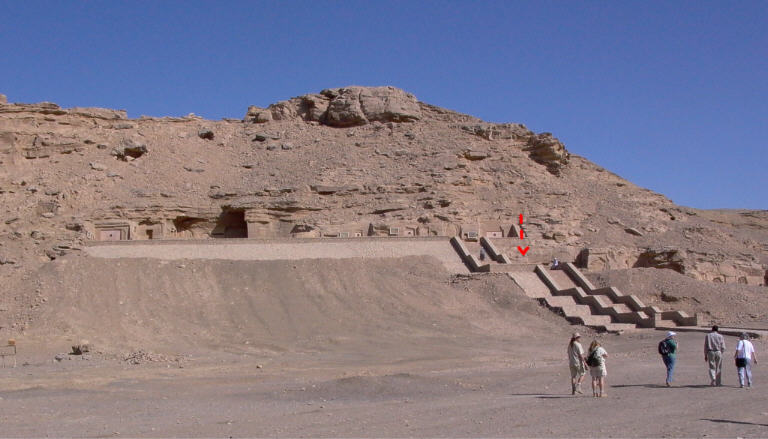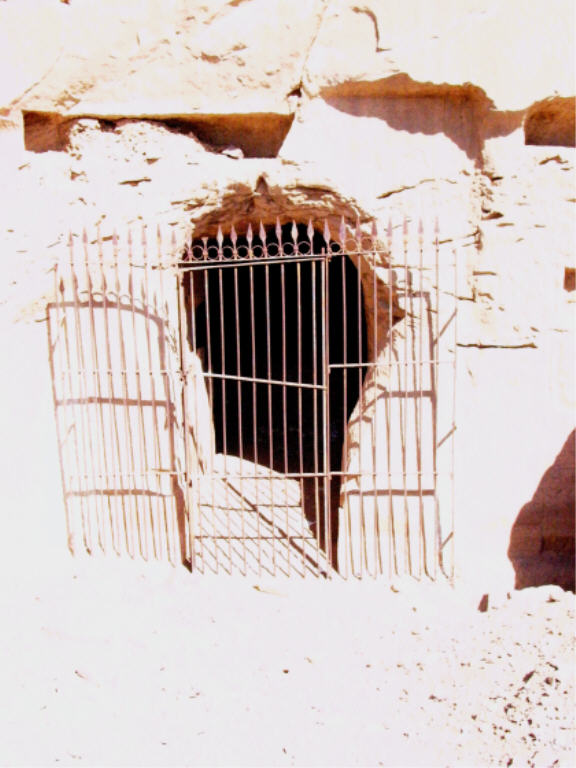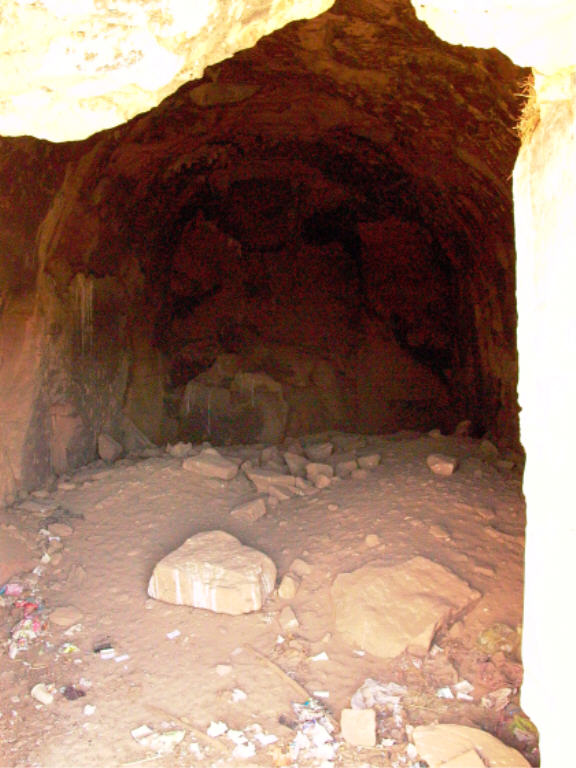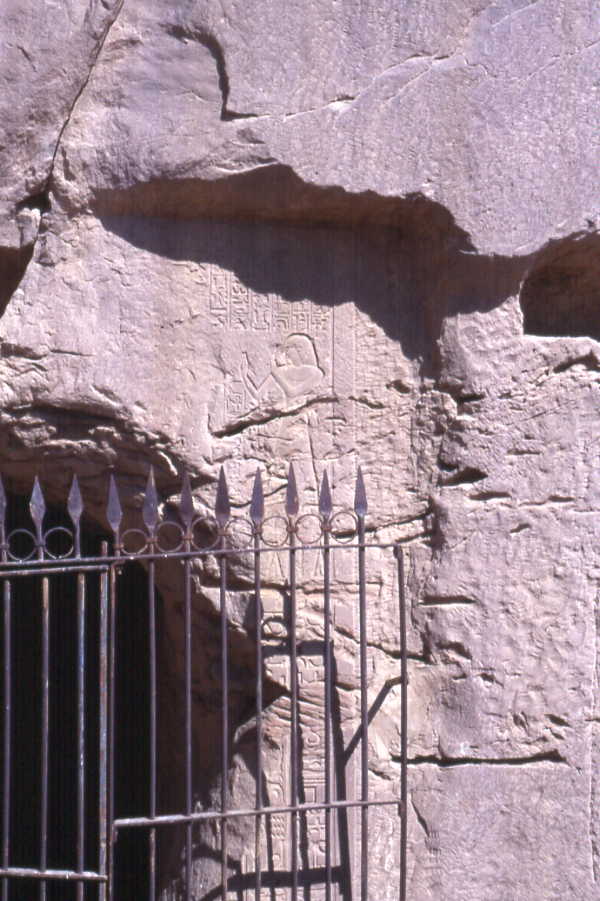 |
Ahmose Pennechbet |
last update:
29.12.2006
|
Historical Data
| Name |
Title(s) |
|
Origin |
Tomb |
Ahmose Pen-nechbet
JaH-msw P-A-n-nXbt
|
Chief Steward of the Storehouse (Granary,
etc.)
Officer, Treasurer, King's first son of Elkab
|
already testified during the reign of Thutmosis II; one of the tutors of Princess Neferu-Ra;
his wife Ipu (Ipw)
is possibly identical with the nurse of Thutmosis III who was also
called Ipu (Roehrig, 1990) and who had been the mother of his Great Royal
Wife ZAt-JaH (SatJah); testified at least until regnal year 5
(Helck, W., ZÄS 121, 1994) |
Elkab
|
Tomb Nr. 2 in Elkab together with his
brother Chaemwese (P&M V, 176/177)
or:
Thebes, since funerary cones were found only at Thebes
|
| Parents
|
|
|
|
|
Father:
Amenhotep
Jmn-Htp
|
|
|
|
|
| Mother:
|
|
|
|
|
| Brother(s): |
|
|
|
|
| Chaemwese |
|
|
|
|
| Children:
|
none known |
|
|
|

|
The tomb of Pennechbet at Elkab is largely destroyed and not accessible for the public (see photos below). It is located only a few meters right
of the staircase leading to the tombs opened (the re arrows marks the
location).
|
| The top left photo shows the entrance of the tomb, the
top right photo shows the destroyed room. Right and left from the
entrance there are still remains of the original inscriptions (photo by
E. Noppes). |
| Ahmose Pennechbet has left a rather extensive autobiography in
his rock tomb at Elkab. This autobiography was obviously written briefly after the death of
Hatshepsut, thus,
directly after the start of the autocracy of Thutmosis III. In this autobiography
he praises himself to have served under 4 kings: "I have
accompanied the kings of Upper and Lower Egypt, the Gods (= the deceased
kings), under which I have lived, on their campaigns to the southern and northern foreign
countries, to any place they have gone, the king of Upper and Lower
Egypt " Neb-pehti-Ra" (Ahmose I), the blessed one, the king of
Upper and Lower Egypt "Djeser-ka-Ra" (Amenhotep I), the blessed one, the king of
Upper and Lower Egypt "Aa-cheper-ka-Ra "(Thutmosis I) the blessed one, the king of
Upper and Lower Egypt "Aa-cheper-en-Ra" (Thutmosis II) the blessed ones, up to this good God, the king
of Upper and Lower Egypt, "Men-cheper-Ra" (Thutmosis III), who may
live forever."
|
| Due to this autobiography he fought with Ahmes I in Syria, with Amenhotep I in Nubia and probably in Libya, with Thutmosis
I again in
Nubia and against Naharina, and with Thutmosis II against nomads (probably
Bedouins from the southern Palestine). |
| Furthermore, he says::
"I have also been in the favor of the God's wife, the great
royal wife "Maat-ka-Ra" (Hatshepsut), the blessed one; I was
the tutor of her great daughter, the king's daughter, Neferu-Ra, the blessed one, when
she had been an infant."
(quoted after Dorman, 1988, Grimm, Schoske, 1999). |
|
Ahmose Pennechbet enumerates in his biography only the legitimate order of the
kings, the illegitime king Hatshepsut who died shortly before is mentioned
only with her titles "God's Wife of Imen" and
"Great Wife of the King". Suddenly, the king Hatshepsut,
whom he had served a long time, did not exist any longer.
Enumerating the legitimate predecessors of Thutmosis III (see also
Tyldesley, Meyer) possibly points already towards the reason for the
persecution of "Maat-ka-Ra" Hatshepsut (s. also "End
and Persecution" of Hatshepsut). Destroying her monuments and cartouches
as well as replacing her name by his own or those of his father and grandfather proves
Thutmosis III as a direct and legitimate successor in the male line of the
Thutmosid kings - probably more a political necessity (all had no royal blood)
than a personal revenge! |
| Today, three monuments are assigned to Ahmose-Pennechbet: -
the tomb No. 2 at Elkab, together with his brother Chaemwese;
- a basis of a statue, that is today shown in the Louvre (Catalogue-No.
49);
- and the statue "Mr. Finley" today in the Royal Scottish Museum,
Edinburgh (Catalogue-No. 1948.486).
To a large extent the genealogical data given in his tomb are still
unpublished (after Vandersleyen (quoted after Graefe, 1981).
|
| The nurse
Ipw, mother of the
ZAt-JaH Great Royal Wife
to Thutmosis III, is
testified only once on an offering table from Abydos (today in the museum of
Cairo, CG 23034; Roehrig, in 1990). This offering table which was inscribed for
her daugther mentions no other members of the family. Since the brother
Chaemwese had been responsible for the burial of Ahmose-Pennechbet it is not
very likely that Ahmose-Pennechbet had children (which lived long enough to
crare for their fatherīs burial. Although they share the name it is very
unlikely that the nurse Ipw is identical with the wife of Ahmose-Pennechbet. |
|



